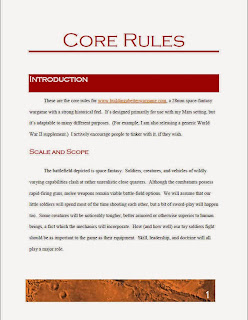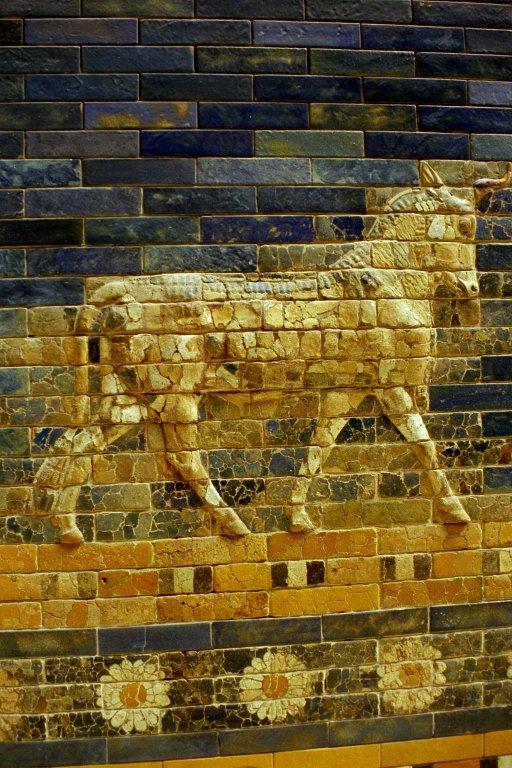I think it's pretty clear that
Warhammer 40k has long had serious problems of game-balance. I enjoy casual games with the system, but in a tournament or other highly-competitive environment, it's far too easy to create lists that are abusive. (
40k's woes are in marked contrast to the relative stability of
Flames of War, as I discussed
here.)
Naturally, I'd like my own game to avoid similar pitfalls, so I've been thinking about the origins of
40k's balance problems, and how to escape them. I have concluded that
40k's woes stem from several sources, and that there is no single, simple fix for them.
Abusive versus Competitive
Let's start with some definitions.
40k's problem is that its current set of codices too easily permits players to produce abusive army lists.
My first definition: "An
abusive army list is an one that maximizes one axis of the army's capabilities to such an extent that it overwhelms the opposing capabilities of any likely opponent."
Any particular army a player can choose has different elements, such as numbers, armor, vehicles, flyers, and so forth. It also has certain countering capabilities: anti-tank weaponry, high-AP marine-killers, anti-air weapon, and so forth. Any of these axises of capability can be increased (usually at the expense of some other axis of capability).
Naturally, players have choice about exactly what kind of army they want to play, and what trades of capability they find desirable. And, indeed, competitive list building (deciding what parts to maximize or minimize or emphasize) is an important and enjoyable part of a bring and battle wargame. Most players try to build lists that emphasize one capability, so that opponents will have trouble countering it.
The difference between a competitive list and an abusive list is then largely a matter of degree.
There are, of course, some necessarily subjective key words in my definition. How much advantage is "overwhelming" and how much is a normal part of the variety of armies? Exactly how does one decide what's likely in an opponent? Some local environments will be different than others. But even if there's some fuzz around the edges, I think the core meaning remains clear enough: an abusive army seeks to win the game before it is played, by fielding a force that a "typical" foe simply will not posses the tools to counter.
My second definition: "A balanced meta-environment is one that does not permit the creation of abusive army lists." Simple. The game lists should prevent any army from becoming so distorted that it's abusive. (Now, it well may still be possible to create an underwhelming army that stupidly forgoes certain key elements, like an army entirely made of lasgun-toting guardsmen, but that's a different issue.)
Abuse Me
An abusive army overwhelmingly maximizes a particular capability. An army list can reach this threshold in any of several ways, or (more subtlety) by some combination of them. Here are the most common offenders:
Under-costed Units
Some units just cost too little for what they do. I'm sure we can all think of examples from 40k. And, honestly, I have a lot of sympathy for the mistakes of game designers. It's difficult to tell, before publication, what's the appropriate value for a unit, because there are so many factors involved. But an under-costed unit is easy to abuse. Take a lot of them, and whatever capability that unit represents will increase with every duplicate choice. Or, if the unit is a mandatory choice, make it as small as possible, so that you have more room elsewhere in the list for your desired axis of capability. (Ie, take only 2 small units of Cultists so you can have more Heldrakes, or take 5 man Dire Avengers squads so you can have more Wave Serpents. Or whatever. )
Over-costed Units
This is the not-so-evil twin of an undercosted unit. It basically makes any army taking them bad, which of itself does not lead to abuse. But if, for example, all of army A's anti-infantry is really good, but all of army B's tanks are too expensive, it may force army B into a bad match-up. For example, armor 14 might be a counter to many abusive builds, but Land Raiders have long been just a bit too expensive. So few people take them. Subtle, but it's a factor.
Spam
"Spam" is internet slang for a duplicated unit. If someone takes three Heldrakes, or three Landraiders, or six units of thirty Chaos Cultists, then they're "spamming" that unit. Spamming is an obvious way to maximize a particular capability: take a unit that has that capability, then take a bunch more. Now, spam is not always abusive. I could take six identical tactical squad units, with a flamer and missile launcher, and no one would care. Spam usually only works if the unit has some really special ability or is under-costed already. Nor is spam entirely the same as being undercosted. There are plenty of units that if run in small numbers are not abusive for the point cost, but if run in large numbers can be. Most armies can deal with one Riptide. They probably can't deal with four. Spam is essentially abuse of the Force Organization chart, and it becomes more common (and annoying) when using multiple FOs, due to allies, high point games, or whatever.
Synergy
It's also possible to spread a capability out among many units, in such a way that when they are combined, the end result is abusive. For example, one unit with an Ignores Cover weapon is an annoyance. An army that takes Ignore Cover weapons on multiple different units may end up with so many weapons that cover (an essential part of the game) just becomes meaningless. Or, there are abilities that can be countered separately, but together "stack" into something crazy good. (For example, the Screamer Star or the Jetbike flying Seer Council.)
Healing the Broken: Is is Possible?
There are systems of "Comp" that try to layer a second set of rules or choices on top of the existing set of Codices -- by limiting force org choices, or forbidding duplicate units, or requiring set percentages of different unit types. But I'm skeptical: I don't think
40k can be fixed in any easy way. The game designers would have to rewrite the line of codices and (I think) fundamentally alter and limit the Force Organization chart.
So what are the lessons for my game? I have a couple of take-aways:
1) If I expect an army to consist mostly of a particular type of unit (like infantry) I must require armies to take them. Low minimums will be abused. So, for my game, I think the core of every army will be three basic squads of troops.
2) Conversely, especially powerful units like vehicles, that don't have a natural counter, should be limited in number. So, for my game, I think armies will be limited to 0-3 light vehicles and 0-1 tanks.
3) Avoid powers that stack. I think all my Doctrines will be limited: only one will affect a unit at a time.
4) I have to get the point values right. If and when I don't get the point values right, I must immediately correct them. Even if it requires errata and FAQs.
5) I must provide game-balance whether I like it or not. Even if I, as the game designer, do not care about creating a tournament-capable, balanced meta-environment, and say so, like
Games Workshop has done, people will still play tournaments with my game and then be surprised it's not balanced.
Enough complaining. Next week: Thanksgiving.



















